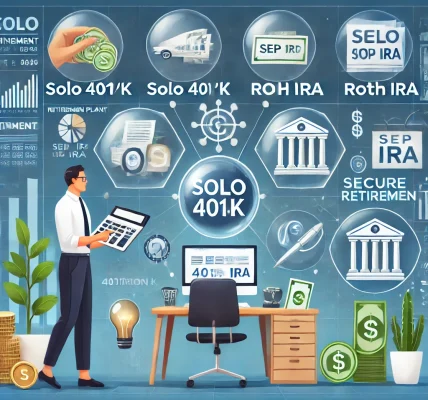Retirement planning is not just about saving money—it’s also about making smart financial decisions that maximize savings while minimizing tax burdens. Various retirement plans offer tax advantages that can significantly impact long-term wealth growth. Understanding these benefits and knowing how to leverage them can help individuals build a more secure financial future.
In this guide, we will explore the tax benefits associated with different retirement plans and strategies to maximize savings.
1. Understanding the Tax Benefits of Retirement Plans
Retirement plans provide tax benefits in three primary ways:
- Tax-deferred contributions: Contributions reduce taxable income in the present, allowing more money to grow over time.
- Tax-free withdrawals: Certain plans, such as Roth IRAs, allow tax-free withdrawals in retirement.
- Tax-free growth: Investments grow tax-free within the plan, compounding wealth over time.
Choosing the right retirement plan depends on factors like income, expected retirement tax bracket, and long-term financial goals.
2. Tax-Advantaged Retirement Plans and Their Benefits
A. Employer-Sponsored Plans
i. 401(k) Plans
- Tax Benefit: Contributions are made with pre-tax dollars, reducing taxable income.
- Employer Matching: Many employers match a portion of contributions, which is essentially free money.
- Tax-Deferred Growth: Investments grow tax-free until withdrawal.
- Withdrawal Taxation: Withdrawals are taxed as ordinary income after retirement.
ii. Roth 401(k) Plans
- Tax Benefit: Contributions are made with after-tax dollars, allowing tax-free withdrawals in retirement.
- Ideal For: Individuals expecting to be in a higher tax bracket in retirement.
iii. 403(b) and 457(b) Plans
- Tax-Deferred Growth: Similar to 401(k) plans, contributions reduce taxable income.
- Penalty-Free Withdrawals: Some 457(b) plans allow penalty-free withdrawals before 59½ if leaving an employer.
B. Individual Retirement Accounts (IRAs)
i. Traditional IRA
- Tax Benefit: Contributions may be tax-deductible, reducing current taxable income.
- Tax-Deferred Growth: Investments grow tax-free until withdrawals begin.
- Withdrawal Taxation: Withdrawals are taxed as ordinary income after age 59½.
ii. Roth IRA
- Tax Benefit: Contributions are made with after-tax income, but withdrawals (including gains) are tax-free in retirement.
- No Required Minimum Distributions (RMDs): Unlike a Traditional IRA, Roth IRAs do not require withdrawals at a certain age.
- Ideal For: Individuals in a lower tax bracket now but expecting higher taxes in retirement.
C. Self-Employed & Small Business Plans
i. Solo 401(k)
- Tax Benefit: Allows high contribution limits with tax-deferred growth.
- Ideal For: Self-employed individuals and business owners.
ii. SEP IRA
- Tax Benefit: Contributions are tax-deductible, reducing taxable income.
- Ideal For: Self-employed individuals and small business owners with few employees.
iii. SIMPLE IRA
- Tax Benefit: Tax-deferred growth and employer-matching contributions.
- Ideal For: Small businesses looking for an easy-to-administer plan.
D. Annuities for Retirement
i. Fixed and Variable Annuities
- Tax Benefit: Investments grow tax-deferred until withdrawn.
- Ideal For: Individuals seeking guaranteed income in retirement.
3. How to Maximize Tax Benefits in Retirement Planning
A. Take Full Advantage of Employer Matching
- Always contribute enough to receive full employer matching contributions in 401(k) and 403(b) plans.
- Employer matching is essentially free money that grows tax-deferred.
B. Balance Taxable and Tax-Free Accounts
- Diversify savings between Traditional (tax-deferred) and Roth (tax-free) accounts.
- This strategy allows flexibility in retirement when managing withdrawals and taxes.
C. Utilize Catch-Up Contributions
- Individuals aged 50 and older can contribute additional funds to 401(k)s and IRAs, increasing tax-advantaged savings.
D. Convert to a Roth IRA Strategically
- Consider converting a Traditional IRA to a Roth IRA during years with lower taxable income.
- Pay taxes upfront to enjoy tax-free withdrawals in retirement.
E. Delay Social Security Benefits
- Delaying Social Security benefits until age 70 increases monthly payments.
- Helps manage tax efficiency when withdrawing from other retirement accounts.
F. Manage Required Minimum Distributions (RMDs)
- RMDs begin at age 73 for Traditional IRAs and 401(k)s.
- Plan withdrawals strategically to minimize tax impact.
G. Consider Health Savings Accounts (HSAs)
- HSAs offer triple tax advantages: tax-deductible contributions, tax-free growth, and tax-free withdrawals for medical expenses.
- After age 65, withdrawals can be used for any expense without penalty (though taxed as income if not for medical use).
4. Common Mistakes to Avoid in Retirement Tax Planning
A. Withdrawing Too Early
- Early withdrawals (before 59½) from 401(k)s and IRAs may result in a 10% penalty and income tax.
B. Ignoring Roth Contributions
- Many people focus only on Traditional IRAs and 401(k)s, missing out on Roth’s tax-free withdrawal advantage.
C. Not Considering Future Tax Rates
- Tax rates may increase in the future; planning for a mix of taxable and tax-free income sources is crucial.
D. Forgetting Required Minimum Distributions (RMDs)
- Failing to take RMDs can lead to hefty IRS penalties (up to 50% of the required amount).
5. Conclusion: Build a Tax-Efficient Retirement Strategy
Maximizing tax benefits in retirement planning requires a strategic approach. Whether contributing to an employer-sponsored plan, IRA, or annuity, understanding the tax implications helps optimize savings and long-term financial security.
By:
- Taking advantage of employer-matching contributions,
- Balancing tax-deferred and tax-free accounts,
- Utilizing Roth conversions and HSAs, and
- Managing withdrawals efficiently,
individuals can create a retirement plan that minimizes taxes while maximizing wealth growth.
Consulting a financial advisor is always recommended to tailor strategies based on individual financial situations and future tax considerations. Smart planning today ensures a financially stable and tax-efficient retirement tomorrow.




